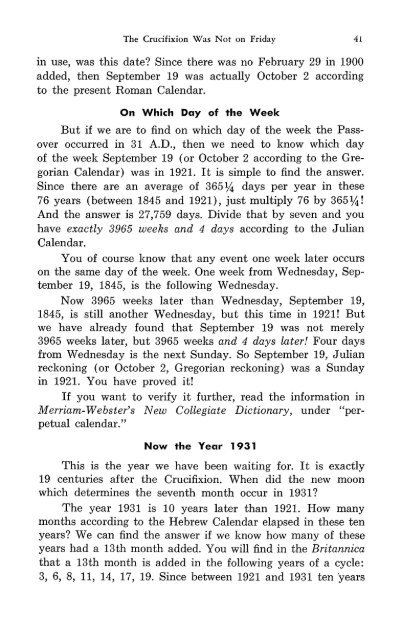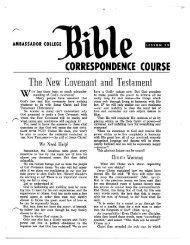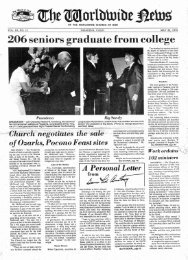Crucifixion Was Not on Friday (1968)_b.pdf - Herbert W. Armstrong
Crucifixion Was Not on Friday (1968)_b.pdf - Herbert W. Armstrong
Crucifixion Was Not on Friday (1968)_b.pdf - Herbert W. Armstrong
You also want an ePaper? Increase the reach of your titles
YUMPU automatically turns print PDFs into web optimized ePapers that Google loves.
The <str<strong>on</strong>g>Crucifixi<strong>on</strong></str<strong>on</strong>g> <str<strong>on</strong>g>Was</str<strong>on</strong>g> <str<strong>on</strong>g>Not</str<strong>on</strong>g> <strong>on</strong> <strong>Friday</strong> 41<br />
in use, was this date? Since there was no February 29 in 1900<br />
added, then September 19 was actually October 2 according<br />
to the present Roman Calendar.<br />
On Which Day of the Week<br />
But if we are to find <strong>on</strong> which day of the week the Passover<br />
occurred in 31 A.D., then we need to know which day<br />
of the week September 19 (or October 2 according to the Gregorian<br />
Calendar) was in 1921. It is simple to find the answer.<br />
Since there are an average of 365l1t days per year in these<br />
76 years (between 1845 and 1921), just multiply 76 by 365l1t!<br />
And the answer is 27,759 days. Divide that by seven and you<br />
have exactly 3965 weeks and 4 days according to the Julian<br />
Calendar.<br />
You of course know that any event <strong>on</strong>e week later occurs<br />
<strong>on</strong> the same day of the week. One week from Wednesday, September<br />
19, 1845, is the following Wednesday.<br />
Now 3965 weeks later than Wednesday, September 19,<br />
1845, is still another Wednesday, but this time in 1921! But<br />
we have already found that September 19 was not merely<br />
3965 weeks later, but 3965 weeks and 4 days later! Four days<br />
from Wednesday is the next Sunday. So September 19, Julian<br />
reck<strong>on</strong>ing (or October 2, Gregorian reck<strong>on</strong>ing) was a Sunday<br />
in 1921. You have proved it!<br />
If you want to verify it further, read the informati<strong>on</strong> in<br />
Merriam-Webster's New Collegiate Dicti<strong>on</strong>ary, under "perpetual<br />
calendar."<br />
Now the Year 1931<br />
This is the year we have been waiting for. It is exactly<br />
19 centuries after the <str<strong>on</strong>g>Crucifixi<strong>on</strong></str<strong>on</strong>g>. When did the new mo<strong>on</strong><br />
which determines the seventh m<strong>on</strong>th occur in 1931?<br />
The year 1931 is 10 years later than 1921. How many<br />
m<strong>on</strong>ths according to the Hebrew Calendar elapsed in these ten<br />
years? We can find the answer if we know how many of these<br />
years had a 13th m<strong>on</strong>th added. You will find in the Britannica<br />
that a 13th m<strong>on</strong>th is added in the following years of a cycle:<br />
3, 6, 8, 11, 14, 17, 19. Since between 1921 and 1931 ten 'years

















